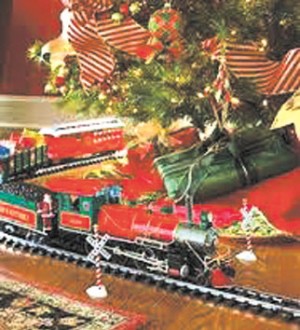Even though we may only realize it in retrospect, children often display behavior very early in life that points to their destiny. In the early 1890s, 7-year-old Joshua Lionel Cowen whittled a miniature locomotive from a scrap of wood and attempted to fit it with a tiny engine — and it exploded. He was unharmed, but his mother’s kitchen sustained considerable damage. Many years later, in his early 20s, he would try the experiment again and succeed. He gave his invention his middle name, and the model train was born.
Cowen sold his first model train to a Manhattan shop owner in 1901 by convincing him the small train running through his Christmas window display would draw attention to his other merchandise. The shop owner returned the next day to order half a dozen more tracks and trains. It appeared while the merchandise in his window was getting attention, the customers’ main question was “Where can we buy the train?” Lionel quickly provided the shop with a dozen train sets consisting of one electric flat car and 30 feet of track and dubbed it the “Electric Express.” Within 12 months Cowen acquired enough capital to start his own company, the Lionel Corporation.
Though a prolific inventor, Cowen’s marketing skills would prove just as valuable to his success. Working from a German tradition, linking toy trains to Christmas, Cowen approached a number of large department stores in New York City, convincing them to incorporate elaborate train setups around their Christmas tree displays. The public reaction to the displays was overwhelming, sales boomed, and America had officially entered the “Golden Era of Toy Trains.”
The years brought many changes as Cowen constantly improved upon his original concept. In 1902 a train set with a “City Hall Park” trolley and a two-foot suspension bridge met with great success. The year 1903 saw the introduction of the B&O locomotive and the motorized Derrick car. And in 1906 Lionel added a third rail which carried the current and the outer rails, which were the ground rails. Three trolleys, two steam engines, two passenger cars, seven freight cars and a small wall transformer completed this groundbreaking set.
In 1929, Cowen unveiled the “Transcontinental Limited.” It cost an unheard of $110, more than the price of a used Model T. Lionel was at the peak of its success when the Depression hit. While many of his competitors closed their doors, Lionel managed to stay afloat by obtaining government contracts.
The war years of the 40s left toy manufacturers with a metal shortage. Lionel stepped up its production of plastic accessories, and once again kept its doors open. When production resumed in the mid-40s, Lionel turned out trains and accessories that are considered by many to be the best in their long company history.
By the mid-1950s, public interest had shifted from trains to airplanes and slot-cars. Christmas of 1953 saw the first considerable drop in sales and with no resurgence of interest, the Lionel Train Corporation closed in 1965.
In 1999 the Lionel electric train was recognized as one of the top ten toys of the 20th century. The little 7-year old boy, who had once blown up his mother’s kitchen, died in 1965, the undisputed “king” of the toy train industry. Until next time ……..Linda
Irvington resident Linda Kennett is a professional liquidation consultants specializing in down-sizing for seniors and the liquidation of estates and may be reached 317-258-7835 or join her on Facebook at Irvington Retro/Vintage/Antique



